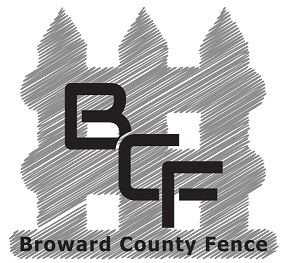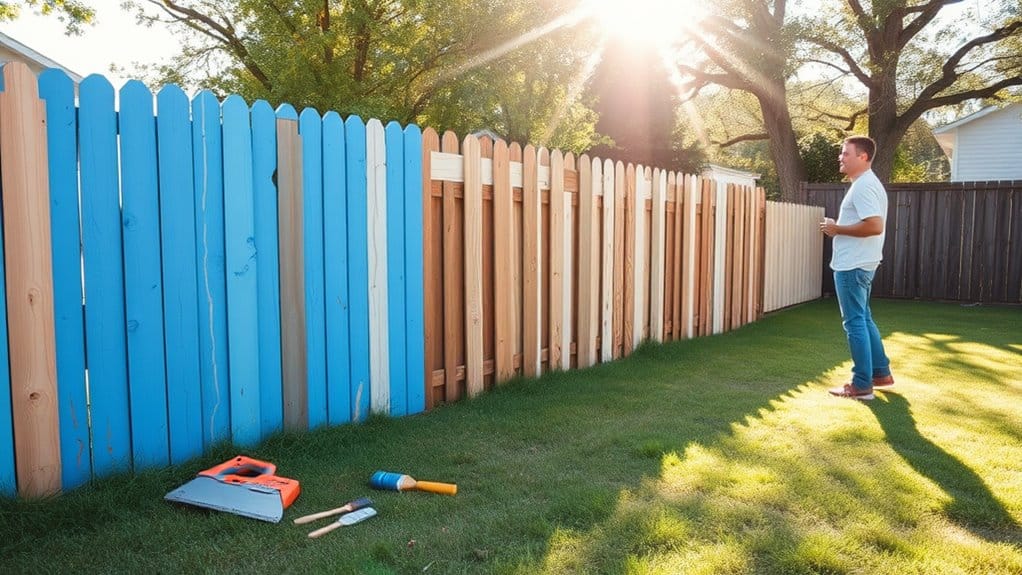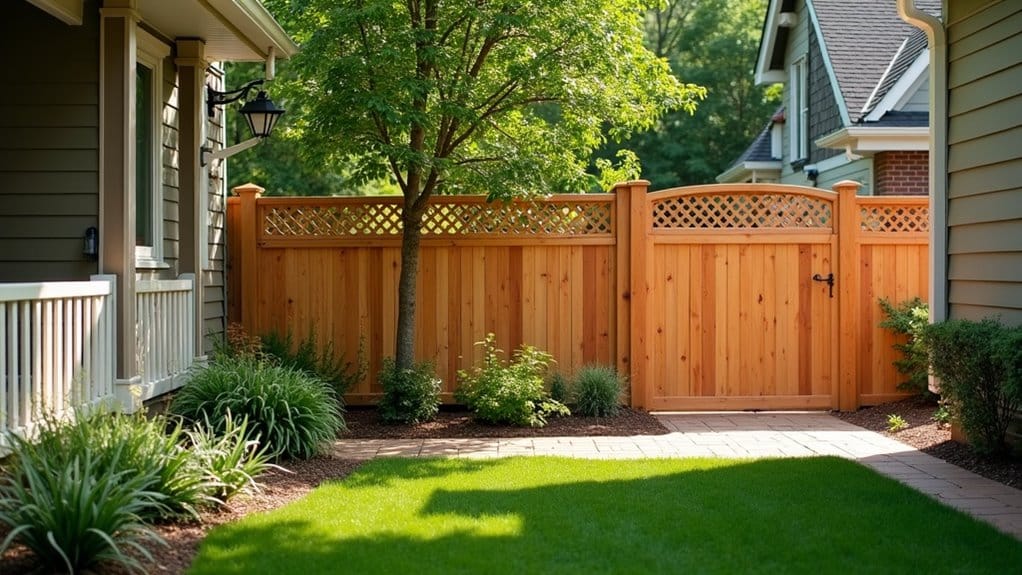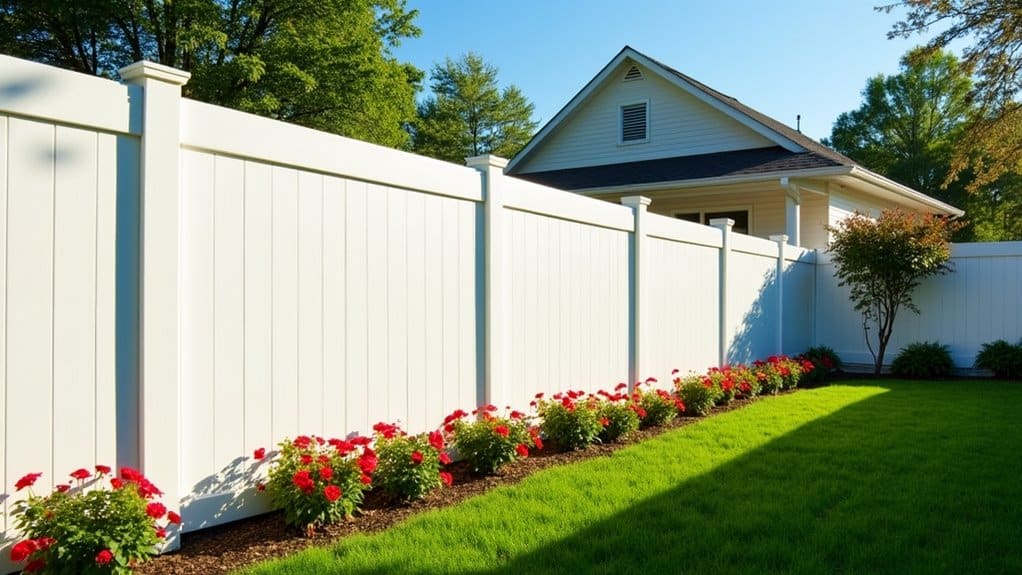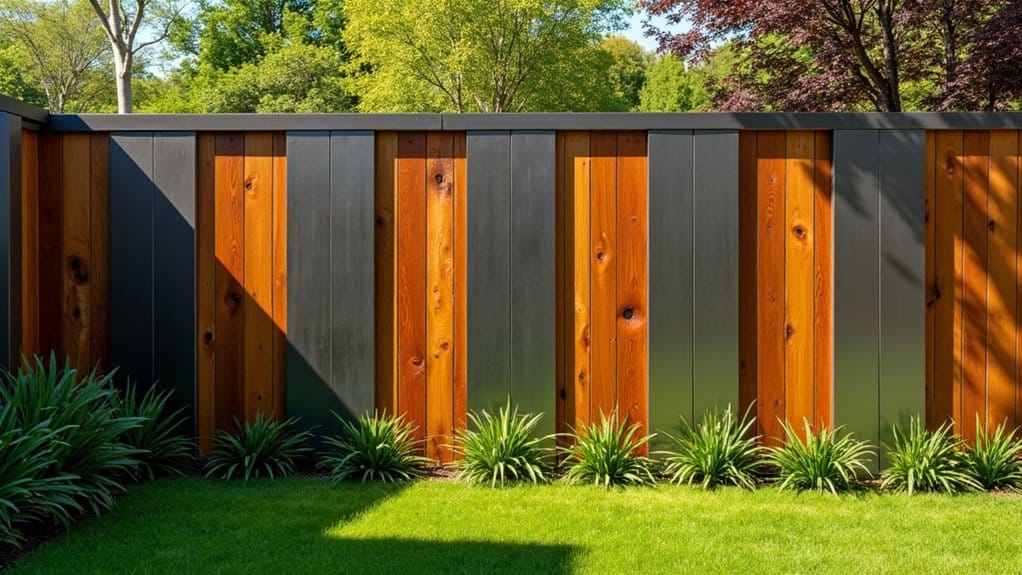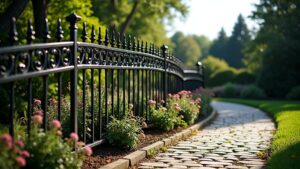DIY residential fencing projects have their pros and cons. On the plus side, you can save up to 70% on labor costs and customize your design. However, be ready for physical work and challenges like measuring errors or using poor materials. Warranties may be limited, and mistakes can be expensive. With careful planning, attention to regulations, and avoiding common mistakes, you can build a durable and attractive fence. Stay tuned for more tips to help ensure your project is a success.
Key Takeaways
- DIY fencing can save homeowners up to 70% compared to hiring professionals.
- You have the freedom to choose your own schedule and design, making it a more personal project.
- Working on your fence helps you learn valuable skills like measuring and using tools, but it can be physically demanding.
- The quality of materials matters; cheap options might break down quickly, leading to more expenses later on.
- Following local regulations and proper installation techniques is essential to avoid legal problems and ensure your fence stands strong.
Overview of DIY Fencing
Taking on a DIY fencing project can boost your property's value and enhance your outdoor space. Start by choosing a fence type that fits your property and looks good—options like wood, vinyl, or aluminum are durable and eco-friendly. Additionally, consider consulting with professionals for insights on local regulations that may affect your project.
Planning is crucial. Think about post spacing, layout, and any slopes in your yard. Remember to check local regulations and obtain necessary permits to avoid issues. Additionally, factor in the timeline and budget for your project to ensure a smooth installation process.
For installation, mark the fence line, dig holes, and set posts in concrete for stability. Ensure your posts are aligned to keep your fence looking neat and upright. Using high-quality materials can help withstand Florida's climate challenges.
Cost Savings of DIY
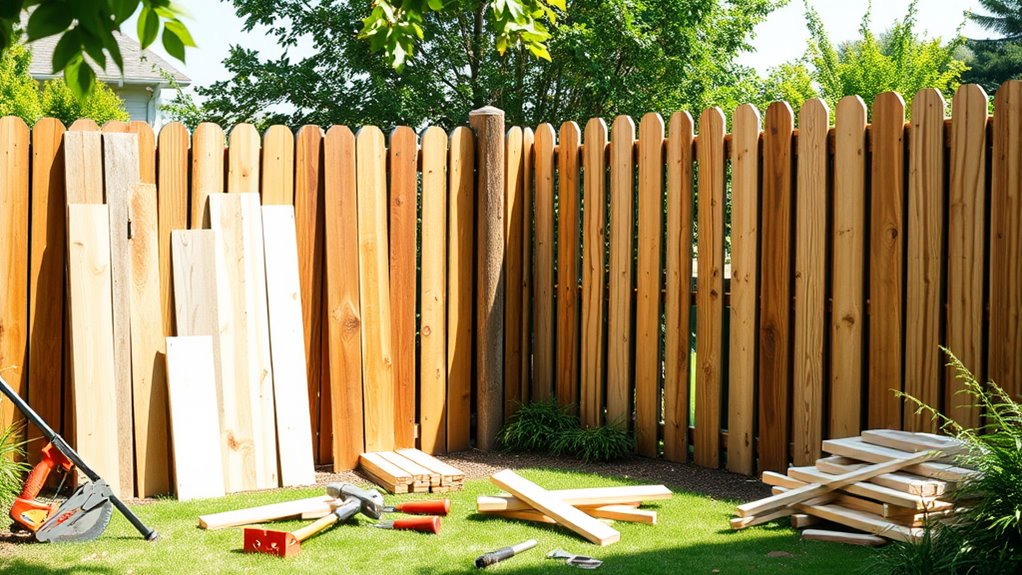
Taking on a DIY fencing project can significantly lower your costs by eliminating labor expenses, which often account for over 50% of the total bill.
You can choose from a variety of budget-friendly materials, allowing you to create a customized fence without overspending. Additionally, selecting durable, low-maintenance fences can reduce the need for repairs down the line, further enhancing your savings. Furthermore, implementing a no-dig fence can streamline the installation process and minimize the time you spend on your project.
Plus, the time and effort you invest now can save you from expensive repairs in the future.
Reduced Labor Expenses
Choosing a DIY fencing project can save you a lot on labor costs—up to 70% compared to hiring professionals. For instance, while the average DIY material cost is around $3,600, a professional bid can reach $12,000. By managing the labor yourself and purchasing materials directly, you can enjoy significant financial benefits. However, keep in mind the potential challenges of DIY projects. Additionally, the current contractor pricing remains high despite decreases in material costs, which further emphasizes the benefits of DIY. When planning your project, consider the material selection based on your budget and exposure to weather conditions.
Here's a quick overview of how labor costs can vary based on project complexity and experience:
| Factor | DIY Cost | Professional Cost |
|---|---|---|
| Basic (Flat Terrain) | $3,600 | $12,000 |
| Intermediate Complexity | $5,000 | $15,000 |
| Advanced (Hilly Terrain) | $8,000 | $20,000 |
| Skill Level (Beginner) | $7,500 | $15,000 |
| Skill Level (Expert) | $4,000 | $12,000 |
This breakdown highlights how much you could save with DIY, but also the importance of assessing your own skills and the project's demands.
Affordable Material Options
Choosing affordable materials for your DIY fencing project can significantly cut costs while still delivering the desired look.
For instance, wood pallets are often free and create a rustic feel. If you're after a classic look, split rail wood is a good option, ranging from $7 to $15 per linear foot, or you might consider barbed wire, which is quite cheap at $0.10 to $0.50 per linear foot. Chain Link Fences are also a cost-effective option for boundary fencing, offering durability and minimal maintenance.
Bamboo is another sustainable choice, priced between $6 and $25 per linear foot, depending on height and color. Chicken Wire Fence is another economical option that can be used to corral small animals and protect gardens.
Reclaimed wood adds character and is budget-friendly as well. With a bit of creativity, you can mix these materials to build an attractive and cost-effective fence that enhances your property without breaking the bank.
Long-Term Financial Benefits**
Taking on a DIY fencing project can save you money upfront by avoiding labor costs. You only pay for materials, which keeps initial expenses low. However, it's crucial to consider long-term expenses that might arise. Investing in quality posts is essential to minimize maintenance and replacement efforts. Additionally, understanding local ordinances can help ensure your project remains compliant and avoids fines.
Here's a quick comparison of immediate versus long-term costs:
| Cost Type | DIY Costs | Professional Costs |
|---|---|---|
| Upfront Expenses | Only materials and tools | Materials + labor fees |
| Maintenance | Potentially higher if not done right | Typically lower with professionals |
| Value Addition | May not increase property value | Generally increases property value |
| Long-Term Repairs | Higher if mistakes are made | Often covered by warranty |
While DIY projects can offer short-term savings, poor installation or material choices can lead to expensive repairs later on. Weighing these factors will help ensure your fencing project remains a smart financial choice.
Flexibility and Control
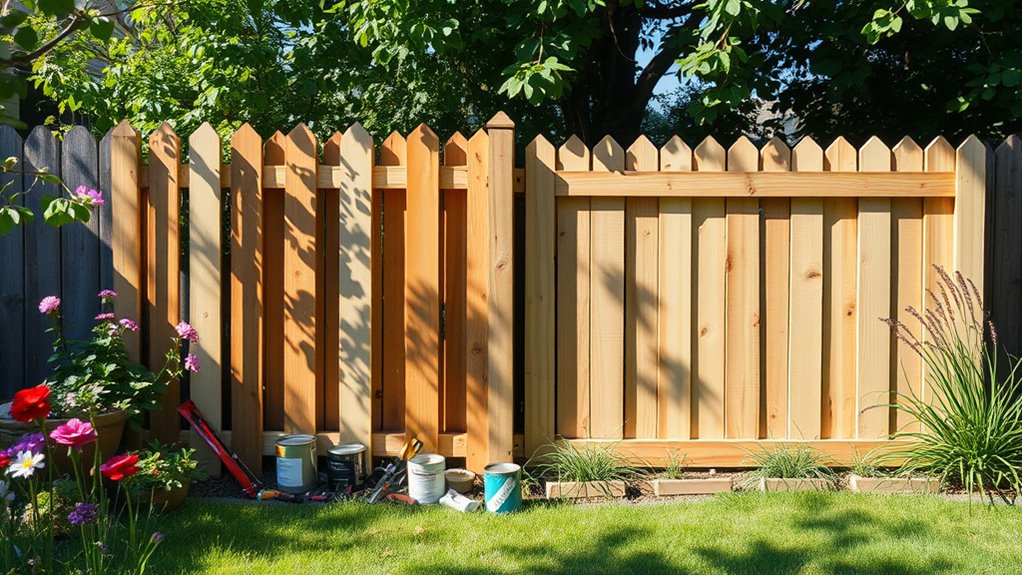
When tackling DIY residential fencing projects, you gain significant flexibility and control. You can work on your own schedule, taking breaks as needed, which is great if your work hours fluctuate or interruptions arise.
You also have the freedom to choose your design and materials. If inspiration strikes mid-project, you can easily switch things up without worrying about extra costs that typically come with hiring a contractor.
Budget control is another advantage. By carefully selecting materials and tools, you can save on labor costs and even use recycled items to further cut expenses. This allows you to manage your spending more effectively, spreading costs over time if necessary. Additionally, you can utilize the 8-1-1 service to mark underground utility lines before digging, ensuring safety and compliance with local regulations.
Finally, you can ensure quality by choosing the best materials and inspecting your work as you go. This hands-on approach gives you a sense of accomplishment, knowing the final result meets your standards.
Learning New Skills
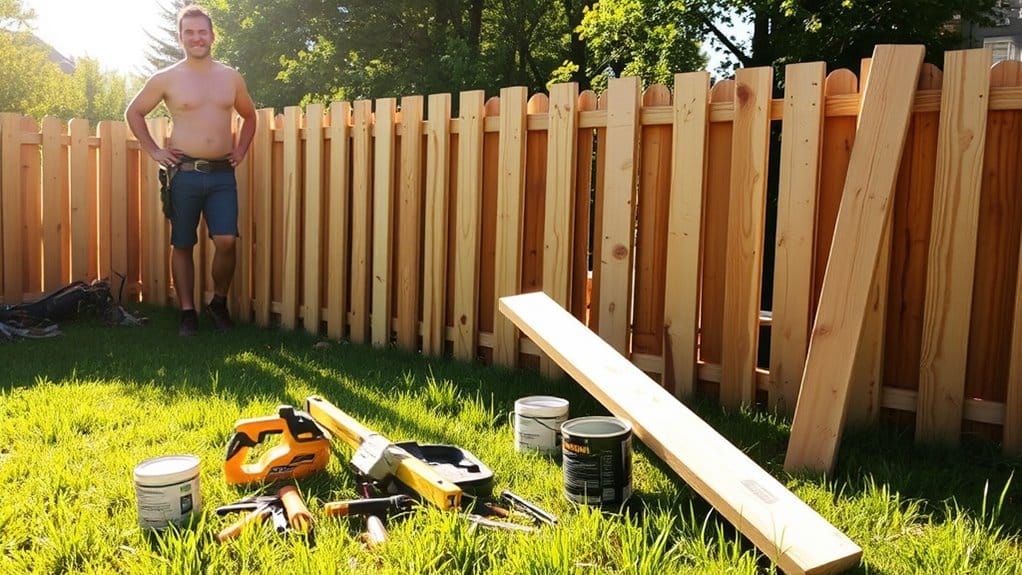
DIY residential fencing not only gives you the flexibility to customize your project but also helps you learn valuable skills. As you cut and assemble materials, you'll become familiar with tools like saws and drills, ensuring you use them safely. Understanding installation techniques and local building codes will prepare you for future projects.
You'll also improve your problem-solving abilities when faced with issues like buried cables or uneven ground. Finding creative solutions to these challenges will keep your fence sturdy. Engaging in varied drills during practice can enhance your skills, ensuring you tackle fencing tasks with confidence.
Time management is another key skill you'll develop. You'll learn to estimate how long tasks will take, considering the learning curve and possible setbacks. Using resources like online tutorials can make the process easier. You'll learn to budget for tools and materials and recognize when it's best to hire a professional. This skill-building experience will boost your confidence and equip you for future DIY tasks.
Immediate Project Start
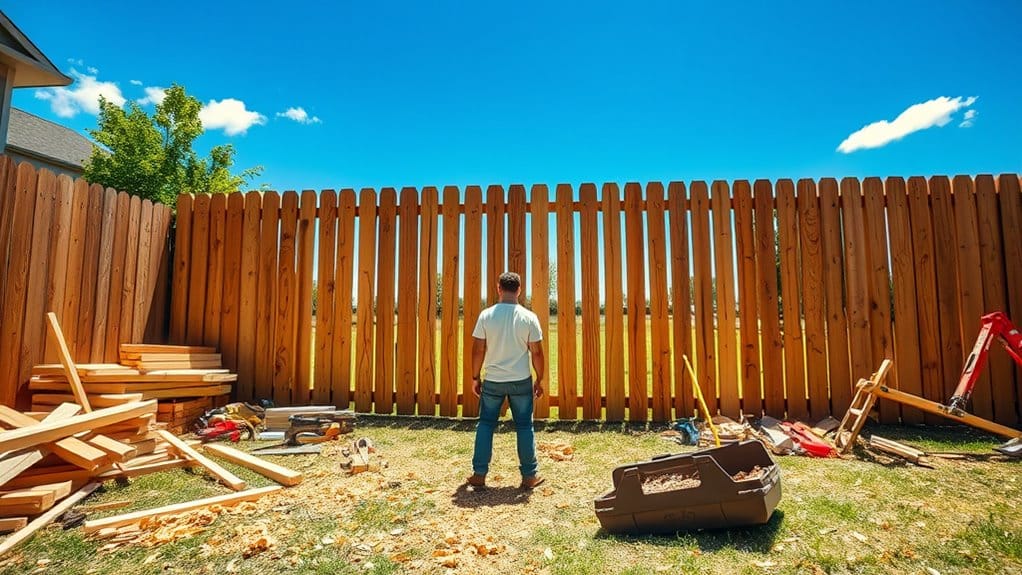
Before starting your DIY fencing project, make sure you've got all necessary checks and permissions in place. This will help you avoid complications and keep your timeline intact.
- Get the Right Permits: Ensure you're meeting local regulations.
- Check Property Lines: Confirm your boundaries to avoid neighbor disputes.
- Talk to Your Neighbors: Engaging with them can lead to better relationships and possible shared costs.
Understanding local fence regulations—like height and materials—is crucial. You don't want to accidentally encroach on someone else's property. Additionally, it's important to research local regulations to ensure compliance with any specific laws regarding fencing.
Plus, many homeowners associations have specific fencing rules, so check those too.
Taking these steps will pave the way for a smoother installation and a successful fencing project.
Customization Options
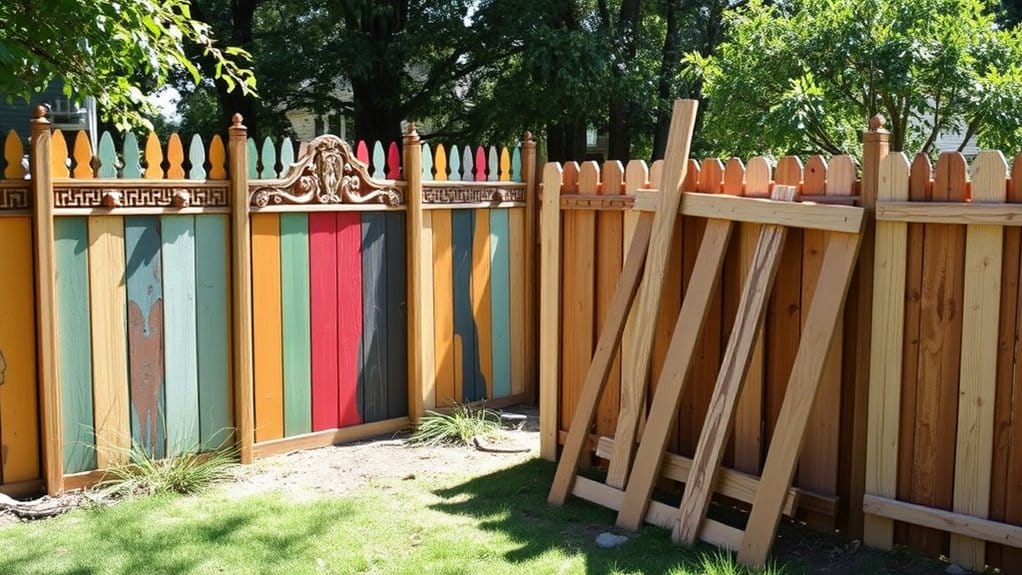
Customizing your DIY fence offers a range of options. You can select from various materials like wood, vinyl, or metal, and tailor the design to match your style. For instance, a rustic wooden fence can complement a country home, while a sleek metal fence suits modern architecture. This adaptability not only boosts your home's curb appeal but also makes the project uniquely yours. Additionally, considering durability options when choosing materials ensures your fence will stand the test of time.
Material Selection Flexibility
When it comes to DIY residential fencing, you have a variety of material options to choose from, each tailored to your style and needs. Current trends include wood and vinyl, each with their own pros and cons. Consider your local environment, as some materials perform better in specific conditions.
- Durability vs. Looks: Find a balance that suits both your aesthetic and longevity needs.
- Maintenance: Vinyl and composite options require less upkeep, while wood needs regular attention.
- Budget: Keep costs in mind; some materials can be quite expensive. Professionally installed fences can enhance property value through improved curb appeal, so it's worth considering the long-term benefits of your material choice.
Choose what works best for you!
Design Personalization Opportunities
Selecting the right materials for your DIY fencing project allows for a range of design personalization options. By choosing different infill materials, finishes, and shapes, you can create a distinctive fence that complements your home and landscape.
Here are some customization options to consider:
| Customization Type | Available Options |
|---|---|
| Infill Materials | Wood, metal, vinyl |
| Decorative Elements | Finials, caps, lattice |
| Functional Features | Shelves, hooks, custom post caps |
With these choices, you can craft a fence that not only stands out but also fits seamlessly with your property.
Style Adaptability Factors
Style adaptability factors are crucial for personalizing your fencing project. They allow you to blend aesthetics with functionality to meet your specific needs.
To achieve a versatile style that enhances your property's look, consider the following:
- Material Choices: Opt for wood, vinyl, metal, or composite materials to match your desired aesthetic.
- Design Styles: Choose from classic picket fences to sleek horizontal slats to fit your vision.
- Additional Features: Add gates, decorative elements, or lighting to boost both functionality and style.
Remember, the height and length of your fence are important for privacy and defining boundaries.
Always check local regulations to avoid issues.
By carefully selecting your materials and designs, you'll create a fence that meets your practical needs and complements your home.
This is your chance to showcase your personal style while ensuring your fence is effective.
Time Commitment Required
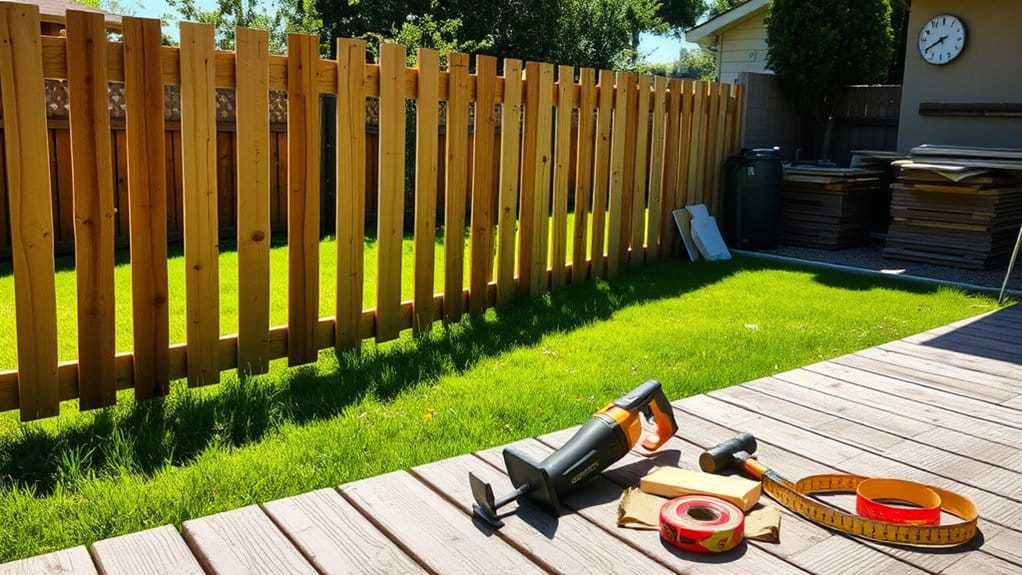
When starting a DIY residential fencing project, it's crucial to know how much time you'll need. Your time commitment can vary greatly based on your yard's size and the fence's complexity.
For instance, a larger yard or a more complex design could take you a week or more, while a standard-sized yard might only take 2 to 4 days for a professional.
Scheduling conflicts can also impact your timeline. If you have work or family commitments, you may not be able to dedicate many hours to the project. Weather can cause delays too—rain or storms can halt your progress.
Additionally, challenging ground conditions, like rocks or roots, can slow you down significantly.
To make the process smoother, plan ahead. Gather all your materials and check local regulations to avoid surprises.
Necessary Skills and Knowledge
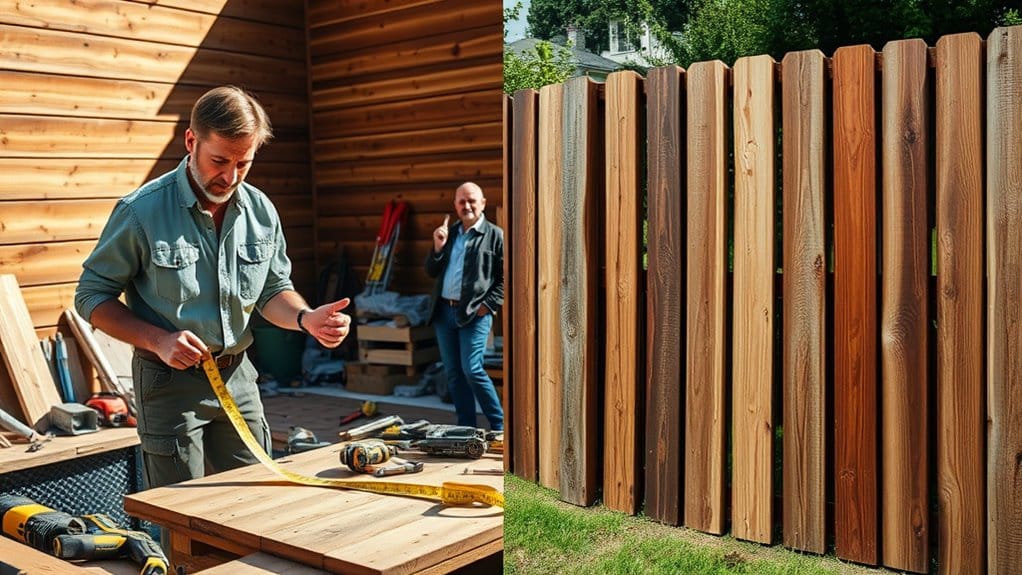
To successfully build a DIY fence, you need to be good at taking precise measurements and operating tools safely.
Accurate measurements ensure your fence looks good and is sturdy, while knowing how to handle power tools keeps you safe.
With these skills, you can create a strong and appealing fence.
Measurement Precision Techniques
Accurate measurements are essential for any DIY residential fencing project. They help you avoid mistakes and ensure your fence is built within your property lines. Here are some key techniques to achieve precise measurements:
- Clearly identify your property boundaries to prevent legal issues.
- Use reliable tools like measuring tapes, wheels, or laser distance meters.
- Always double-check your measurements to catch any errors.
Start by sketching a detailed blueprint of your fence layout, considering slopes and uneven terrain. Tools like aerial photography or a fence calculator can help confirm your boundaries and verify your measurements.
When measuring, keep your tape tight and use stakes to mark the locations of corner posts.
To ensure square corners, use the 3-4-5 triangle technique, which helps create perfect right angles.
Tool Operation Proficiency
Mastering tool operation is crucial for any DIY fencing project. Familiarize yourself with essential tools like post-drivers, power augers, and nail guns, each serving a specific purpose—from digging postholes to attaching panels securely.
Always prioritize safety by wearing gloves and goggles when using power tools.
Tool maintenance is equally important. Keep saw blades sharp and inspect your equipment for wear before starting. Ergonomic tools can help reduce fatigue during long work hours, making the project more enjoyable.
Physical skills matter too. Be prepared to lift heavy materials and dig if needed. Practice with your tools before starting the project to boost your confidence and efficiency.
Utilize online tutorials and manufacturer instructions for a better understanding of each tool's operation and maintenance. With the right skills, you'll be well-equipped for a successful DIY fencing experience.
Physical Labor Involved
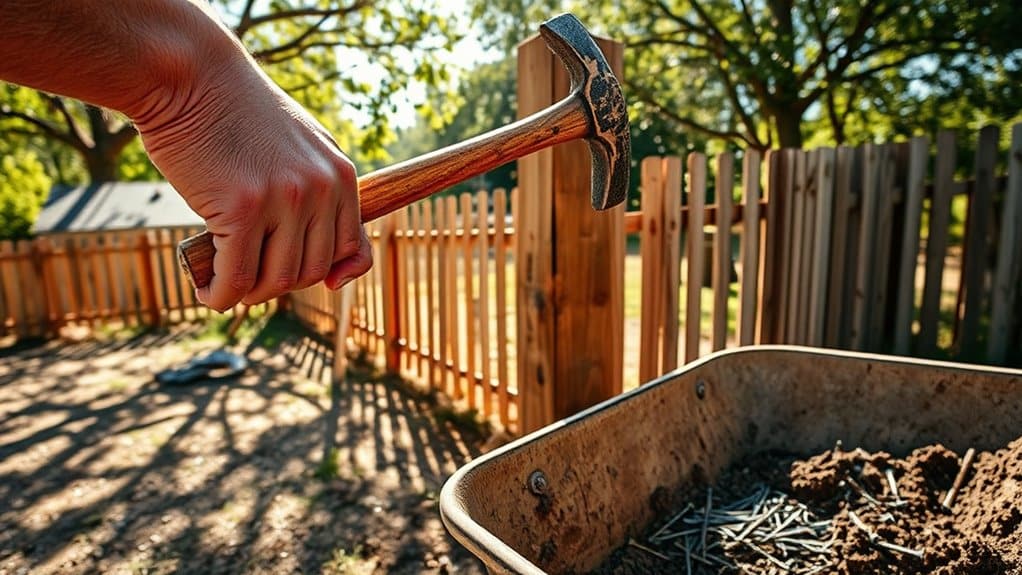
Installing a fence is more than just a weekend task; it's a serious workout. Be ready for some tough physical work that requires strength and stamina. Here's what you should expect:
- Digging post holes: This can be quite challenging, especially with different soil conditions.
- Heavy lifting: You'll need to move fence panels, posts, and bags of concrete, which can be quite heavy.
- Working outdoors: Be prepared for all kinds of weather—sun, rain, or wind.
DIY projects can be rewarding, but they also come with risks. Make sure to use safety gear like gloves and safety glasses to avoid injuries.
If you're not used to heavy physical work, think carefully about whether you can handle it. Remember, working for a long time can lead to fatigue, which increases the chances of mistakes or accidents.
In short, if you're ready for the effort and take safety seriously, building a fence can be a fulfilling project. Just evaluate your abilities before you start!
Quality and Durability Concerns
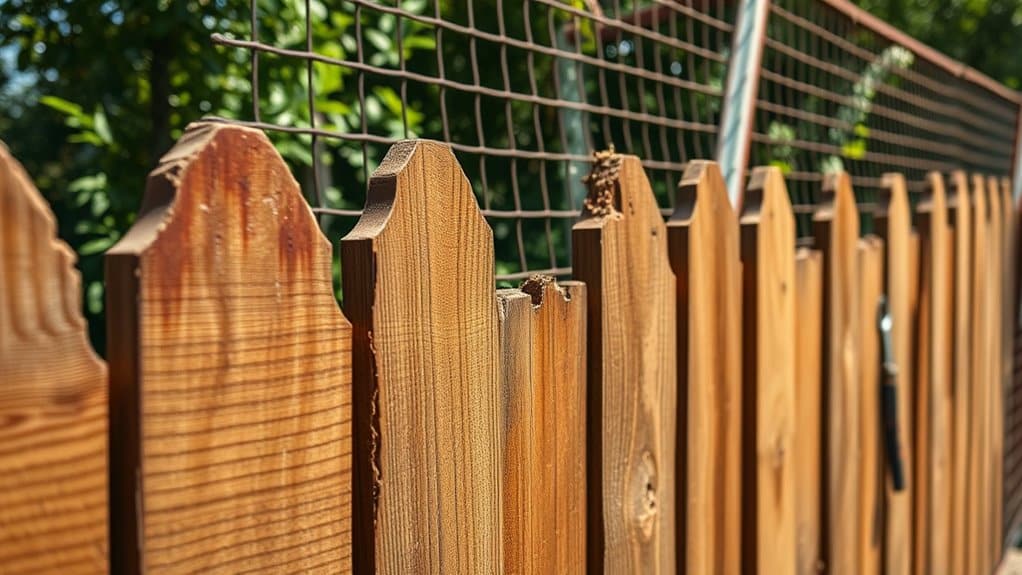
When installing your fence, consider the quality and durability of the materials. Store-bought options often don't match the strength of professional-grade materials, which can shorten your fence's lifespan.
While DIY projects might save money, using inferior materials may lead to quicker replacements.
Installation methods are also crucial. If you don't dig fence post holes deep enough or use the wrong concrete mix, your fence may lean or collapse.
Inexperience can result in mistakes that weaken stability, especially on uneven terrain or with hidden obstacles. Careful planning is essential.
Regular maintenance is key to keeping your fence durable. Ignoring repairs or using low-quality materials can lead to expensive replacements.
Warranty Limitations
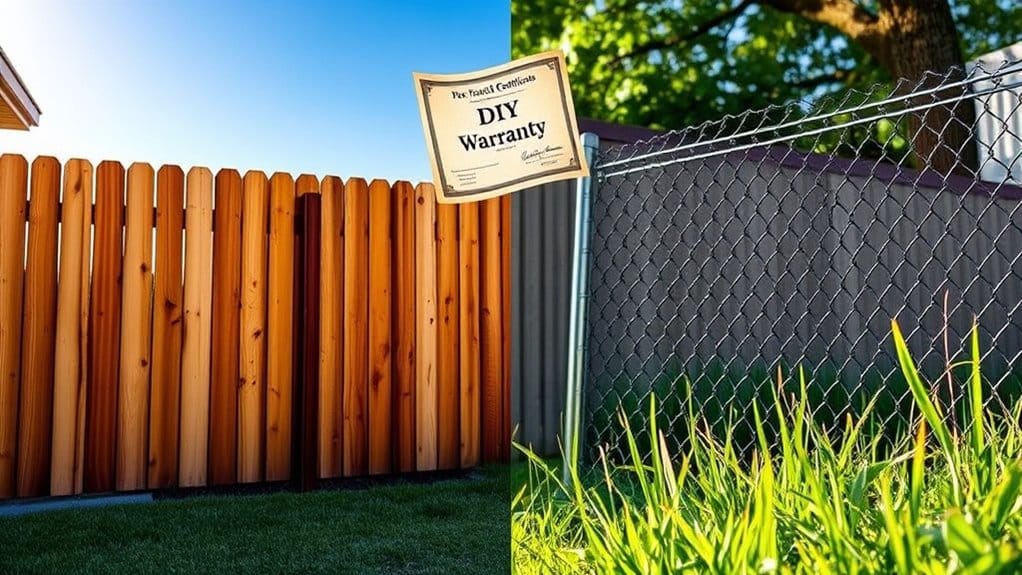
Warranties for DIY fencing projects often have limited coverage.
If you make an installation mistake, you could risk voiding your warranty.
For example, if a fence panel is incorrectly installed and it breaks, you mightn't be able to claim a replacement.
It's crucial to understand these limitations to make informed decisions during your project.
Limited Coverage Options
Navigating warranty limitations is important when planning your DIY fencing project. Here are some key points to consider:
- Material Matters: Different materials have different warranty lengths. For example, vinyl and aluminum typically last longer than wood.
- Non-Transferable: Most warranties only cover the original homeowner, meaning future buyers may not be protected.
- Limited Protection: Warranties often exclude damage from natural disasters and normal wear and tear, which could impact your investment.
Understanding these details is crucial. If you choose to go the DIY route, you may miss out on the comprehensive coverage that comes with professional installations.
For instance, some companies offer lifetime guarantees on their workmanship, but this usually doesn't cover damage from natural events or misuse.
If your fence experiences cracking or warping, those issues mightn't be covered either.
Installation Error Consequences
Understanding warranty limitations is crucial for your DIY fencing project. Many homeowners overlook that installation mistakes can void warranties, leaving them unprotected against defects. Without professional guidance, errors can arise, leading to warranty issues and potentially higher costs down the line.
| Error Type | Consequence | Warranty Impact |
|---|---|---|
| Anchor Post Errors | Fence instability and failure | May void manufacturer warranty |
| Environmental Mistakes | Damage from poor soil and alignment | Exclusions for negligence |
| Pre-Planning Mistakes | Legal troubles and expensive fixes | Potential fines and removal |
| Utility Line Neglect | Costly damages and safety hazards | No coverage for damages |
| Zoning Law Ignorance | Fines and fence removal | Warranty may not cover legal issues |
Being mindful of these potential errors can save you time, money, and headaches.
Key Factors to Consider

When embarking on a DIY residential fencing project, a few key factors can significantly impact your success. By carefully planning and executing your project, you can save time, money, and frustration.
- Know your property boundaries to avoid conflicts with neighbors.
- Select the right materials that suit your style and budget.
- Assess your terrain for any installation challenges.
Start by confirming your property dimensions and understanding local regulations to prevent legal issues and delays. Choose materials that fit your budget and the intended use of the fence.
Whether you opt for wood, vinyl, or metal, consider how long they'll last and how much maintenance they require.
Then, evaluate the complexity of your project. Uneven ground or existing obstacles can complicate installation and extend timelines.
Clearly outline and mark your fence layout to ensure safety during the build.
Lastly, prioritize safety while working. Use the right tools and securely install your posts below the frost line.
Common Mistakes to Avoid
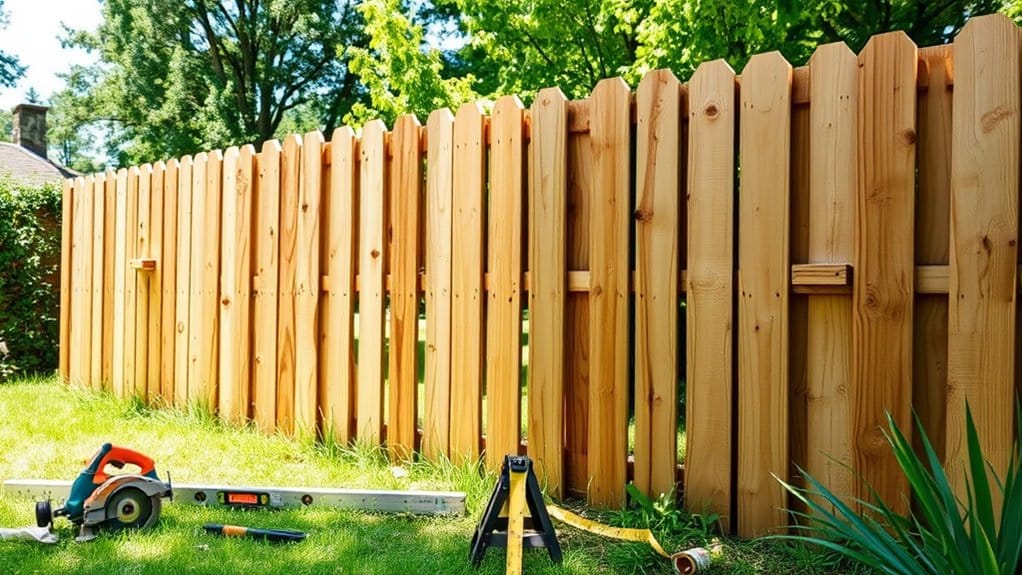
DIY fencing projects can easily go off track due to common mistakes. Being aware of these pitfalls can help you save time, money, and frustration. Here are key mistakes to avoid:
| Category | Common Mistakes | Tips to Avoid Them |
|---|---|---|
| Legal Issues | Ignoring zoning laws | Always check local regulations first. |
| Not verifying property boundaries | Confirm your property lines with a survey. | |
| Installation Errors | Shallow post holes | Dig deep for stability—at least 1/3 of the post height. |
| Incorrect measurements | Measure twice to ensure accuracy. | |
| Material Selection | Poor quality materials | Opt for durable materials that can withstand your climate. |
| Incompatible materials | Choose materials suited for your fencing purpose. | |
| Planning & Execution | Lack of planning | Draft a detailed project plan before starting. |
| Ignoring soil conditions | Check the soil type to avoid future issues. |
Comparing Professional vs. DIY
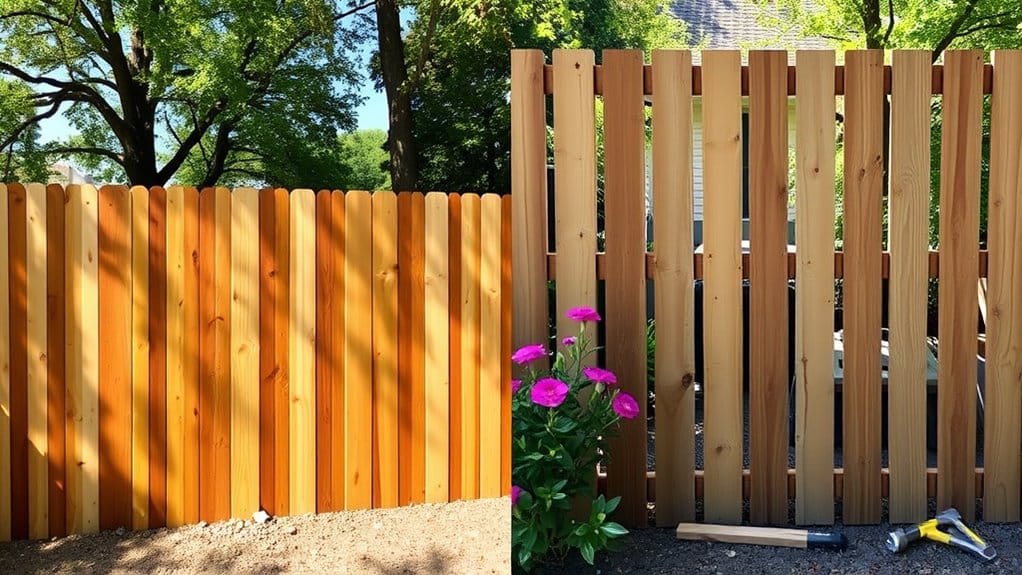
When choosing between professional installation and a DIY approach for your fencing project, consider these important factors:
- Project Complexity: If your design is straightforward, DIY might be a good fit. For tricky landscapes, professionals are usually better equipped.
- Time Availability: Think about how much time you can realistically commit to the project.
- Skill Level: Be honest about your experience with tools and measurements.
DIY can be appealing for its customization and potential cost savings. However, professionals bring expertise that can save you time and ensure quality. They know local regulations and can finish the job much faster, preventing potential issues.
Also, consider the physical demands and warranty options. DIY can be labor-intensive and mistakes may lead to expensive fixes. Hiring a pro often includes warranties, giving you peace of mind.
Ultimately, the decision between DIY and professional installation depends on your skills, available time, budget, and the project's complexity.
Frequently Asked Questions
What Types of Fencing Materials Are Best for DIY Projects?
For DIY fencing projects, wood like cedar or treated pine is a great choice for its customizability and natural look. If you prefer something low maintenance, vinyl is durable and practical. Both options cater to different needs and styles, making it easy to find the right fit for your project.
How Do I Maintain My DIY Fence Over Time?
To keep your DIY fence looking great and lasting longer, follow the principle of prevention over repair. Regularly check for signs of wear, like rust or rot, and address them promptly. Clean your fence annually and apply a protective sealant every few years. For wooden fences, consider staining or painting to enhance durability. Simple actions like trimming nearby plants can prevent damage too. Keep it maintained, and your fence will serve you well for years.
Can I Build a Fence Without a Permit?
Building a fence typically requires checking local regulations and permit requirements. For instance, if your fence is taller than the allowed height or uses specific materials, you'll likely need a permit. Ignoring these rules can lead to fines or legal issues, so it's best to verify the requirements before starting your project.
What Tools Do I Need for a DIY Fence Installation?
For your DIY fence installation, you'll need basic tools like post hole diggers, shovels, and a level. Make sure to wear safety gear, such as gloves and safety glasses, to keep the project safe and smooth.
How Do I Ensure My Fence Is Level and Straight?
To ensure your fence is level and straight, think of a tightrope walker—balance is essential. Use the tight string method for leveling and follow these simple tips for accurate post placement and alignment.
Conclusion
Choosing DIY fencing is like starting a new project—it offers freedom and savings but needs careful planning and skill. Consider the benefits, like cost-effectiveness and personalization, alongside the challenges, such as time and expertise required. If you're unsure, don't hesitate to ask for help. With the right effort, your DIY fence can be a beautiful and secure addition to your home.
